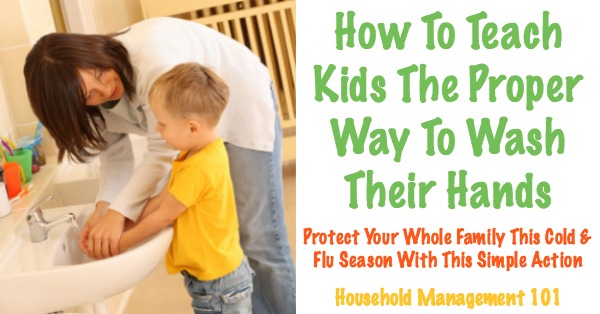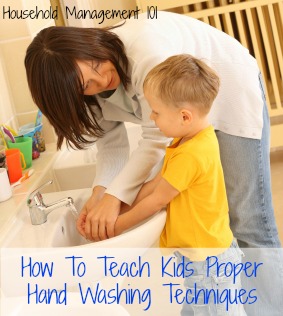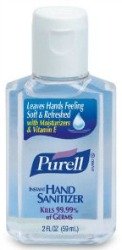
|
Teach Kids Proper Hand Washing Technique - Instructions And How To VideosTeaching kids proper hand washing technique is one of the best, cheapest and most effective ways to prevent or slow the spread of germs within your family.  The importance of hand washing cannot be stressed enough. Further, as we all know, in houses with kids, we need all the help we can get in stopping the spread of germs and disease, because our little bundles of joy are not always the cleanest bunch, and love to put all kinds of things into their mouths. When Do You Need To Wash Your Hands?When you need to wash your hands is generally pretty common sense. On the other hand, kids aren't necessarily born with common sense. Therefore, make sure you explain to your children the importance of proper hand washing technique in these situations:
Cough And Sneeze Into Your Shoulder Or Elbow Something they are generally teaching kids in schools and daycares today, which makes lots of sense, is to cough and sneeze into your shoulder or elbow, instead of covering your mouth or nose with your hands. This is a great way to still not spread your germs further into the room, while at the same time keeping your hands, which are used more, and thus more likely to spread germs than an elbow, for example, cleaner. My personal problem with this method is that I wasn't taught it as a child, and generally it is my children that remind me. Hopefully they have developed better habits about this than I did. Additional times when adults need to remember to use proper hand washing technique in our homes include:
How To Wash Hands: Proper Hand Washing TechniqueFortunately, proper hand washing technique in the home does not require scrubbing up to the elbows like before surgery, and it is simple enough that with practice and consistency small children can do it properly and effectively. Step 1: Use soap and warm (not hot) water. Especially with children you will need to supervise the temperature of the water, from a comfort and safety perspective. It is neither comfortable nor safe for the water to be too hot or too cold. Step 2: Use running water to wash your hands. It is easier to flush away germs while washing your hands if you use running water. Further, although it may seem convenient to create a handwashing station for kids where they all use the same water to clean their hands, it will not be as effective in keeping germs from being spread, and could actually promote the spread of germs. Step 3: Scrub all parts of hands, rubbing them together, for 15-20 seconds. Many experts suggest having children sing a song, such as This is the Way We Wash Our Hands, while they wash their hands to make sure they wash long enough. Step 4: Rinse away all soap under running water. Again, running water more effectively flushes away germs down the drain than standing water. Step 5: Dry hands thoroughly with a paper towel or air dryer if possible, but at least with a clean towel. This is one of the hardest things to do in a home, versus in a bathroom at a restaurant or store with your kids. The reason that the CDC recommends using a paper towel, which can be thrown away, or an air dryer is because it prevents recontamination of your hands with germs after washing, such as can happen when you dry your hands with a dirty or used towel. In a home generally we don't keep disposable towels by the sink for use by the family. Therefore, I highly recommend changing these towels regularly, every 1-2 days at a maximum, and perhaps more often when illness is spreading in your community or schools, and definitely when illness is spreading in your home. How To Properly Use Hand Sanitizer When You Cannot Wash Your HandsSometimes we touch lots of surfaces, or shake lots of hands, or otherwise think the criteria have been met where we should wash our hands, but no sink is available. This happens for me and my family often when we go out to eat, shop, or even to the park to play. For situations like this you should carry alcohol-based hand sanitizer, with at least 60% alcohol, to use instead, because it removes a significant amount of germs from your hands and is fast-acting. Please be aware that ingestion of even small amounts of hand sanitizers by children can be dangerous, since they are alcohol based. Therefore, use extreme caution when allowing a small child to use these products, supervise them carefully so they don't try to put any in their mouths, and perhaps, depending on age, apply it for them and make sure they cannot put their hands in their mouths until their hands are dry. Video From The CDC On How To Wash HandsThis video below is quite short, but explains the highlights of proper hand washing technique. Additional Video On Hand Washing With Specific Tips For Parents And ChildrenI like this video below because it gives some practical advice for dealing with hand washing and kids. Books To Help Kids Learn To Wash Their Hands ProperlySometimes your kids learn best through reading and discussing a book which is written at their level. Here are some recommended children's books which discuss the importance of hand washing. Related Pages You May EnjoyHow To Make Homemade Disinfectant How To Videos For Your Home And Family Go From Proper Hand Washing Technique To Home Page |
Let's Stay Connected!Visit My Other WebsitesStain-Removal-101.com
Home-Storage-Solutions-101.com
|
|

|
||
|
Return To Top | Home Page | Blog | Newsletter | Contact Me | About Me | Sitemap | Privacy Policy | Disclaimer | Disclosure | ||
|
Copyright © 2008 - 2025 - Flanery Companies, LLC - All Rights Reserved
| ||



Share Your Comments, Thoughts & Ideas